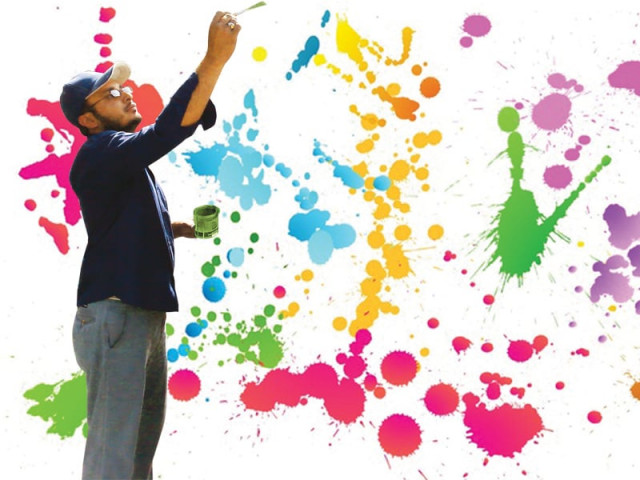
‘Go America Go,’ ‘Qatlon ko giriftar karo warna…,’ ‘Mehboob ap kay qadmoon main’ and ‘Mardana kamzori ka shartia illaj’ are some of the many attention-grabbing messages menacingly painted on walls that line Karachi’s thoroughfares, constantly reminding people of someone’s presence. As a shadow of its former self now however, these wall paintings stand as faded reminders of a period when wall chalking was the only form of political, commercial and social advertisement.

The artists who once painted larger-than-life movie posters have now been driven to the brink of unemployment by new invasive technologies. COURTESY: MUHAMMAD ARSHAD BAIG
“There was a time when I [would] earn as [much] as Rs5,000 in a day,” says 35-year-old Anayatur Rahman who entered the profession 15 years ago, right after completing his matriculation. While remembering his golden days, Rahman recalls that natural talent wasn’t enough to ascend the ladder and despite his artistic gift, he had worked hard to learn the art. He explains that a minimum training period of five years that includes calligraphy is crucial to master the art. For him, even the thought of leaving this profession is scary. “Only 30% of work is left, and that too is limited to the shutters and boards of shops. It’s getting difficult to survive on meagre earnings.”
Artists like Rahman have had to make some tough decisions due to the limited scope of the market. While they are available for a lesson to those who want to learn the skill out of passion, mostly art students, they refuse to transfer their knowledge to newcomers in the profession. The motive is not to increase the pool of artists in this poorly paid profession.
With a diverse portfolio that features paintings of cricketers, footballers and hockey players on walls, company logos on oil tankers and corporate sign-boards, Rahman now finds himself seated in a tiny eight by two feet shop in Gulshan-e-Hadeed, Karachi, waiting for projects to work on. “I have stopped wall chalking [for] the last five years. I didn’t feel comfortable when people (house owners) [would] scold and [give my painting] a contemptuous look for which I was just being paid Rs50.”
To make matters worse, political activists now simply spray their messages across walls. The trend has gained popularity with the availability of cheap spray paints that can be used by anyone to paint a message in almost a quarter of the time required by a professional artist. This directly translates into a reduced risk of being caught and harassed by either the police or opposing party workers. A problem that Rahman has confronted quite often, adding that the ‘investor’, the person sponsoring the act, never gets painted into the picture or is ever held accountable. When arrested however, Rahman says, “We had to work at the police station without getting any money. At [the] most, they used to provide paint.” Many of the faded name plates and emblems on police vans are touched up by these unpaid artists.

(Above) Anayatur Rahman paints his sports heroes and (below) a portrait of the founder of our nation by Muhammad Arshad Baig. COURTESY: ANAYATUR RAHMAN
Those in the trade have taken a major hit from the forceful tide of innovation and technological advancements; from basic spray paint to a panaflex banner and now the omnipresent cable and satellite television networks. Muhammad Arshad Baig, a graduate who claims to have designed the Vita Bread logo, was forced to leave the profession after over two decades. To make ends meet he now runs a school in Korangi and admits that “even a pan walla prefers panaflex to painting.”
Movie posters also are now printed instead of being painted, and this can partially be traced to the disappearance of painters. And even if you did find a painter, “who would they paint for when there is no film making?” says Malik Fida, a contractor at the Lalazar Cinema located in Quaidabad, lamenting the decay of the local film industry. According to Fida, printing an average-sized panaflex poster, around 10 by 15 feet, costs nearly Rs4,500 and can be ready within a day while a painter would charge Rs2,000 for the same poster. Although cost-effective, the paint job only lasts a week and begins to fade while the panaflex poster stands the test of time and can be reused.
But as the law of the market states, supply is only driven by demand. Thus, in the absence of meaningful work, this breed of artists might one day cease to exist altogether.
Rizwan Shehzad is a reporter for The Express Tribune Karachi desk. He tweets @r_shehzad
Published in The Express Tribune, Sunday Magazine, December 8th, 2013.


















COMMENTS
Comments are moderated and generally will be posted if they are on-topic and not abusive.
For more information, please see our Comments FAQ